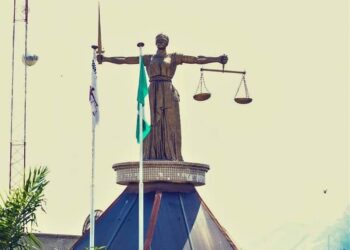In this piece, respected member of the inner bar and rights activist, Mr Ebun-Olu Adegboruwa (SAN) examines the landmark events that took place in 2019 which suggest a bright future for the nation’s judiciary in years ahead.
Surviving ups and downs, wading through the labyrinth, wobbling and fumbling, the judiciary still recorded some major leaps for year 2019, through the intervention of the present administration. Even though we have gone through thick and thin from January till now, we have also experienced historic advancements in the administration of justice generally, which we cannot gloss over, as we sit to plan for the coming year 2020. Let us therefore embark upon a review of the good sides, whilst you please help bear in mind the title of this piece, chosen deliberately to highlight the major positive landmarks recorded in the judicial sector, in the outgoing year.
Undoubtedly, the bulk of judicial activities in Nigeria are in Anambra, Lagos and Rivers States, all followed closely by the Federal Capital Territory, Abuja. Early in the year, Lagos State blazed the judicial trail by launching its new High Court (Civil Procedure) Rules on January 21, 2019, containing several landmark innovations targeted towards achieving smooth and efficient administration of justice. This came with the Expeditious Disposal of Civil Cases Practice Direction No. 1 of 2019, meant to clear old cases pending in the courts through the Backlog Elimination Programme (BEP). The new Rules also brought with it the Expeditious Disposal of Civil Cases Practice Direction No. 2 of 2019, dictating a new regime of Pre-Action Protocol, essentially targeting alternative dispute resolution as a means of settling disputes before cases are filed in court. The new Rules replaced that of 2012, which had been in operation for seven years. Many States have since updated their High Court Rules.
The Federal High Court reviewed its own Rules on May 10, 2019, when the Chief Judge enacted the Federal High Court (Civil Procedure) Rules, 2019, replacing the 2009 Rules, which had been in operation for ten years. Earlier in January 2019, the same court effected a marginal increase in the welfare package for judicial officers from 305,000:00 monthly, to 355,000:00. The new Federal High Court Rules was long awaited, given the strategic role being played by the court because of its expanded jurisdiction.
A landmark event that the judiciary witnessed in 2019 took place on March 22, 2019, when the President inaugurated the special Committee on Autonomy of State Legislature and the Judiciary. Earlier on in June 2018, the President had assented to the Bill for the amendment of the 1999 Constitution known as Financial Autonomy of State Legislatures and State Judiciaries (Fourth Alteration, No.4) Act of 2018, meant to overcome the monumental challenge of funding for the judiciary of the States. We had all heaved a sigh of relief at the coming into effect of this major amendment only to realize that the executive arm in the various States would not allow it to see the light of day. The President then decided to set up a 22-man Committee known as The Presidential Implementation Committee on the Autonomy of State Legislature and Judiciary, with the Honourable Attorney-General of the Federation as the Chairman. The mandate of the Committee was to ensure the full implementation of the 4th Alteration to the Constitution and thus free these important sectors of our democratic experiment, from the stranglehold of the executive arm.
The judiciary is empowered by the Constitution to entertain and determine disputes between persons and persons or between persons and government or between governments and governments. The conflict margin is more on the executive-judiciary angle because of the obvious and excessive impunity of the executive arm, especially the law enforcement agencies.
The general thinking of most Governors is to cage the courts and starve the judiciary of funds, as a means of rendering it ineffective so that lawlessness can thrive unchallenged or where challenged, unchecked.
Most Governors are therefore not comfortable with a viable and independent judiciary, which they dread as a veritable tool in the hands of the people, to challenge and overturn all manner of excesses.
Through the office of the Attorney-General and Commissioner for Justice of the various States, the executive governors have perfected the style of holding the judiciary captive, starving it of needed fund and infrastructure.
So, in most cases, the judiciary is forced to go begging cap in hand, for funding. And assuredly as we all know it, he who pays the piper calls the tune. This was the very ugly scenario before the ‘revolution’ of the 4th Alteration to the Constitution, seeking to free the legislature and the judiciary, from the very firm grip of the executive.
The Fourth Alteration Act No.4 of 2018 cleared the way for the funding of the Houses of Assembly and Judiciary of the States, directly from the Consolidated Revenue Fund of the States. It amended the existing section 121 (3) of the Constitution by stating that “any amount standing to the credit of the House of Assembly of the State and the Judiciary, in the Consolidated Revenue Fund of the State shall be paid directly to the said bodies respectively; in the case of the judiciary, such amount shall be paid directly to the heads of the courts concerned.” It is indeed revolutionary, for a sitting President to agree to grant full autonomy and independence to the other two arms of government. And the President didn’t stop there but proceeded, as a mark of demonstration of his commitment to this bold initiative, to set up The Presidential Implementation Committee, for the enforcement of the provisions of the 4th Alteration Act, comprising mostly of seasoned professionals and other stakeholders.
The Presidential Implementation Committee on Autonomy of State Legislature and Judiciary (PICASOLEJ) was consequently inaugurated and charged to set the ball rolling. It held a two-day retreat in Abuja and came up with a 12-point communique, some of the high points of which are as follows:
* The 4th Alteration Act has been observed more in the breach than in compliance.
* There are various levels of minimal compliance in various States but all fall short of the expected compliance, as budget performance across 36 States of the federation show that while the least allocations to state judiciary in the past three years was 0.6 per cent of the state budgets, the entire allocation was 4.89 per cent.
* The governors as heads of the Executive Arm of Government should begin full implementation of the financial autonomy granted the legislature and the judiciary.
* They should equally adopt the budgeting model operating at the federal level where the sum due to the judiciary and the legislature are captured as first line charge in the budget laid before and passed by the Legislature.
* The budget proposal of the legislature and judiciary should be defended before the relevant committees of the legislature.
* The total sum, both Capital and Recurrent, approved in the Annual Budget of the state, should be released monthly on a pro–rata basis by the Accountant General of the State, directly to the heads of the legislature and the judiciary, and heads of Judicial Service Committee or Commission.
* The budgeted sum, Capital and Recurrent, howsoever described, should be released to the Judiciary to be spent by the Judiciary on the projects, programmes and capital development of the Judiciary, including recruitment and training of personnel. And so for the Legislature.
* The current practice in some states where appropriated recurrent expenditure due the judiciary and legislature in the budget were released to the judiciary and legislature and the capital components are warehoused in the Executive should be abolished.
Just last Friday, December 21, 2019, Governor Seriake Dickson of Bayelsa State, himself a lawyer, complied with the Fourth Alteration Act by granting financial autonomy to the judiciary and the legislative house in the State. Other States are expected to comply with this global trend.
Also in year 2019, a number of States adopted the Administration of Criminal Justice Act as their own law, some with minor modifications.
This year also, new judges have been appointed across board, covering both state and federal judiciaries, in a bid to ease the congestion in the courts, even though their number seems few and far between. A new Chief Judge was sworn in for the Federal High Court, whilst a new President mounted the saddle at the National Industrial Court.
In the outgoing year, the Nigerian Law School graduated a record 4,000-plus lawyers, whilst the Legal Practitioners Privileges Committee elevated 38 senior lawyers to the prestigious Rank of Senior Advocate of Nigeria.
The new Federal High Court complex in Lagos is nearing completion whilst the Annex in Abuja is also receiving attention. Last week, a new division of the Court of Appeal was approved for Delta State, with more divisions expected for other States in the coming year.
No doubt there is so much room for great improvement, but this piece is meant to highlight some positive aspects of the judicial sector for year 2019. I know you are wondering aloud about some other “issues” that I have not addressed here. They have been addressed earlier and will still be discussed subsequently, suffice it to state that this particular adventure is to showcase the good sides of the judiciary, for 2019, under this administration.



